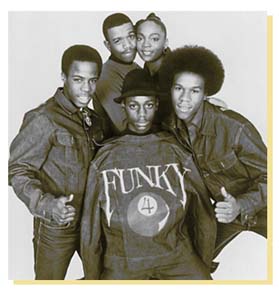![[Metroactive Music]](/music/gifs/music468.gif)
![[Metroactive Music]](/music/gifs/music468.gif)
[ Music Index | Metro | Metroactive Central | Archives ]
On Top of Sugar Hill Label
A new boxed compilation charts the history of a seminal hip-hop label
By Nicky Baxter
IN THE MID-1970s, when hip-hop began welling up from the streets of the Bronx, Brooklyn and New Jersey, everyone, including those making the music, thought of the new sound as just more pop ephemera. Hip-hop touched black youth in a way disco could not, but this new beat was considered little more than party music, a fad. As it turned out, the music produced not just quick cash but an entire industry, and Sugar Hill Records played a big part in that evolution.
Rhino's elaborately packaged boxed set The Sugar Hill Records Story provides more than just a collection of groove-driven numbers, it preserves a slice of hip-hop history. Encompassing more than 50 of the label's most popular recordings, this five-CD compilation also comes packed with a 12-inch vinyl recording of Grand Master Flash & the Furious Five's "The Message," the rap hit that catapulted the music into popular music's national and international arena.
Even before Sugar Hill's founders, Sylvia and Joe Robinson, stumbled onto the new wave of U.S.African genius, rap was being recorded and sold on cassettes. Already, rap progenitors like Kool Herc and Grandmaster Caz were rocking the mic at parties and in parks, but DJs ruled--rappers were then little more than adjuncts.
Later, things would be different. Sugar Hill's story spans the rise and eventual decline of DJs and the ascension of rappers whose ghetto poetry could be traced back to DJs like Jack the Rapper and a Philly cat who called himself Jocko.
Some historians of the genre trace the origins of the idiom to James Brown's "King Heroin," while still others point to the Last Poets and Gil Scott-Heron as the genre's prototypal figures. Ultimately, attempting to locate the genesis of rap is as fruitless as searching for the first bluesman or woman.
What we do know is that the Robinsons' label was the first to give rap the boost required to catapult it from the streets of New York to a worldwide phenomenon. Formed a decade and a half ago, Sugar Hill probably wouldn't have gotten off the ground were it not for Joe Robinson Jr., who picked up the vibe and, with encouragement from his parents, helped form the Sugar Hill Gang, whose "Rapper's Delight" bumped its way up to the No. 4 position on the black singles chart in 1979. From there, the family-owned company signed up other star-time acts, such as Grand Master Flash, the Treacherous Three, Funky Four + 1 and Spoonie Gee.
ALTHOUGH SOME of the material on the compilation is of dubious significance--Positive Force's "People Get on Up"; Sequence's "Here Comes the Bride" in particular--the vast majority would still deserve serious airplay if radio programmers weren't so obsessed with currency.
The various versions of "Rapper's Delight" and "The Message" obviously stand the test of time. Ice Cube's "Check Yo Self," for instance, samples the latter. Other new-school rappers, from Dr. Dre to Busta Rhymes, have dusted off Sugar Hill tracks for inspiration.
As mentioned earlier, these early recordings were strictly party fare; only later would social consciousness invade hip-hop. Although gang violence was rife in the Bronx, Brooklyn and elsewhere, so-called reality rap was curiously absent in the beginning. There are, however, a couple of familiar concerns that have carried over to today's new-school rap: the obsession for getting paid and its inevitable corollary, individualism.
Significantly, Sugar Hill's early raps were accompanied by real instruments. There's a warm, organic feel to much of this music that would nonetheless be scrapped for sampling and synthetic devices. Indeed, even now, there's some debate among hard-core hip-hop heads about the legitimacy of using a band to assist rappers. Thus, while musicians were integral to the idiom's early development, groups like Digable Planets are relegated to rap's periphery for using real players.
There are grooves both rare and renowned sprinkled throughout the package: "Rapper's Delight," an extended exercise in orgiastic pleasure; the neo-griot rapping on "The Adventures of Grandmaster Flash on the Wheels of Steel" and "That's the Breaks"; "It's Good to Be Queen" (featuring Sylvia Robinson); "New York, New York," recently recorded by Tha Dogg Pound; and "Beat Street," to name only a few.
After all is said and done, The Sugar Hill Records Story's real significance is twofold: first, as a comprehensive chronology of hip-hop's embryonic years, and second, as a reminder that indie labels were not confined to rock. Lastly, like rock, rap was all over the map musically, borrowing from disco, R&B and rock--no single designation could contain it. Which is more than can be said for hip-hop today.
[ Metro | Metroactive Central | Archives ]
This page was designed and created by the Boulevards team.

Counting on Success: The Funky 4 Plus 1 was among the many hit-making acts that made Sugar Hill Records their home.
From the February 20-26, 1997 issue of Metro